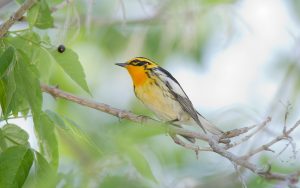
Blackburnian Warbler
Photo by William H. Majoros, on Wikipedia
View: Forest degradation drives widespread avian habitat and population declines
by Matthew G. Betts et all, 2022 in Nature Ecology & Evolution. The full text is publicly available.
Also view 2022 Bird Study for highlights and Press Reports which include an interview with the lead author.
Abstract
In many regions of the world, forest management has reduced old forest and simplified forest structure and composition. We hypothesized that such forest degradation has resulted in long-term habitat loss for forest-associated bird species of eastern Canada (130,017 km2 ) which, in turn, has caused bird-population declines. Despite little change in overall forest cover, we found substantial reductions in old forest as a result of frequent clear-cutting and a broad-scale transformation to intensified forestry. Back-cast species distribution models revealed that breeding habitat loss occurred for 66% of the 54 most common species from 1985 to 2020 and was strongly associated with reduction in old age classes. Using a long-term, independent dataset, we found that habitat amount predicted population size for 94% of species, and habitat loss was associated with population declines for old-forest species. Forest degradation may therefore be a primary cause of biodiversity decline in managed forest landscapes.
Tip of the hat to Tree Frog Forestry News for carrying the OSU article in their Daily News for April 29, 2022
Some related pages and posts on NSFN
Forests succession, deadwood
Page on NSFN under Natural History/Birds/ “A couple of lists of birds observed or compiled by the late Bill Freedman and associates illustrate how forest harvesting can have strong effects on bird communities by their effects on successional habitats and dead wood.”
Species dependent on OG
Page on NSFN under Natural History/Conservation/NSDNR-Old-Forest-Policy/
Petition launched to “Protect birds from being destroyed during nesting season” in Canada quickly reaches 1000 signatures 7Jun2020
Post June 7, 2020
Why we need a Precautionary Biodiversity Landscape Plan for Nova Scotia 16Mar2020
Post on March 16, 2020 What we have now is a precautionary plan to protect wood supply in NS
Bev Wigney on proposed changes to the Canada Migratory Bird Regulations that would allow exceptions to the prohibition against disturbance of nests 24July2019
Post July 24, 2019
| Are cats more destructive to Nova Scotia’s forest birds than clearcutting? Post, June 8, 2018 NSDNR says Yes. The science indicates that there are far more direct kills of birds by cats year to year than from forestry operations but the indirect effects of extensive clearcutting on short rotations in Nova Scotia are much more damaging in the longer term |
Birds nests versus industrial forestry in Nova Scotia & what the Independent Review can do for us
Post Jan 10, 2018
nsforestnotes.ca/natural history/Birds/2022 Bird Study
Highlights from the article
nsforestnotes.ca/natural history/Birds/Press Reports
These include an interview with the lead author, transcribed
